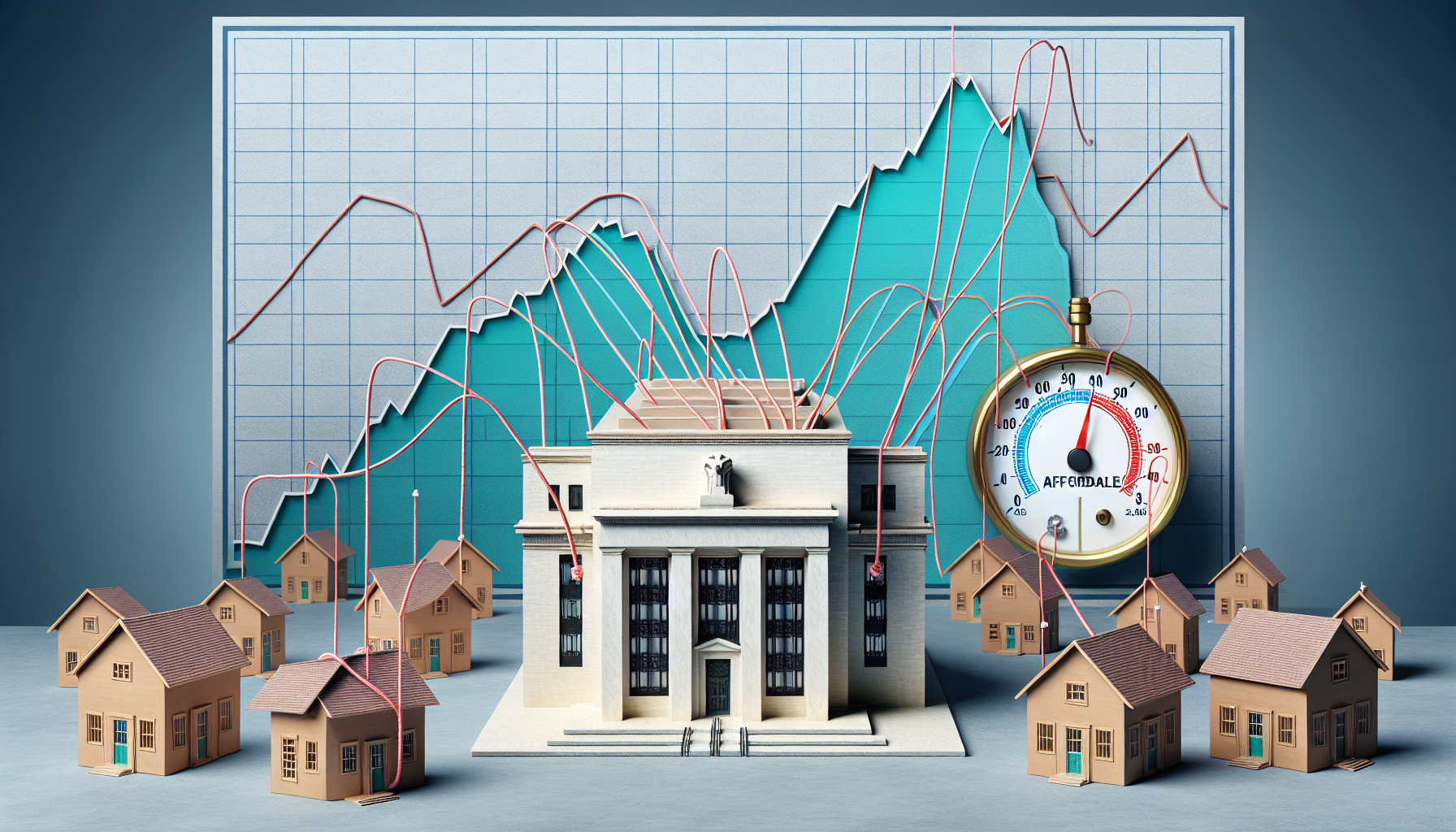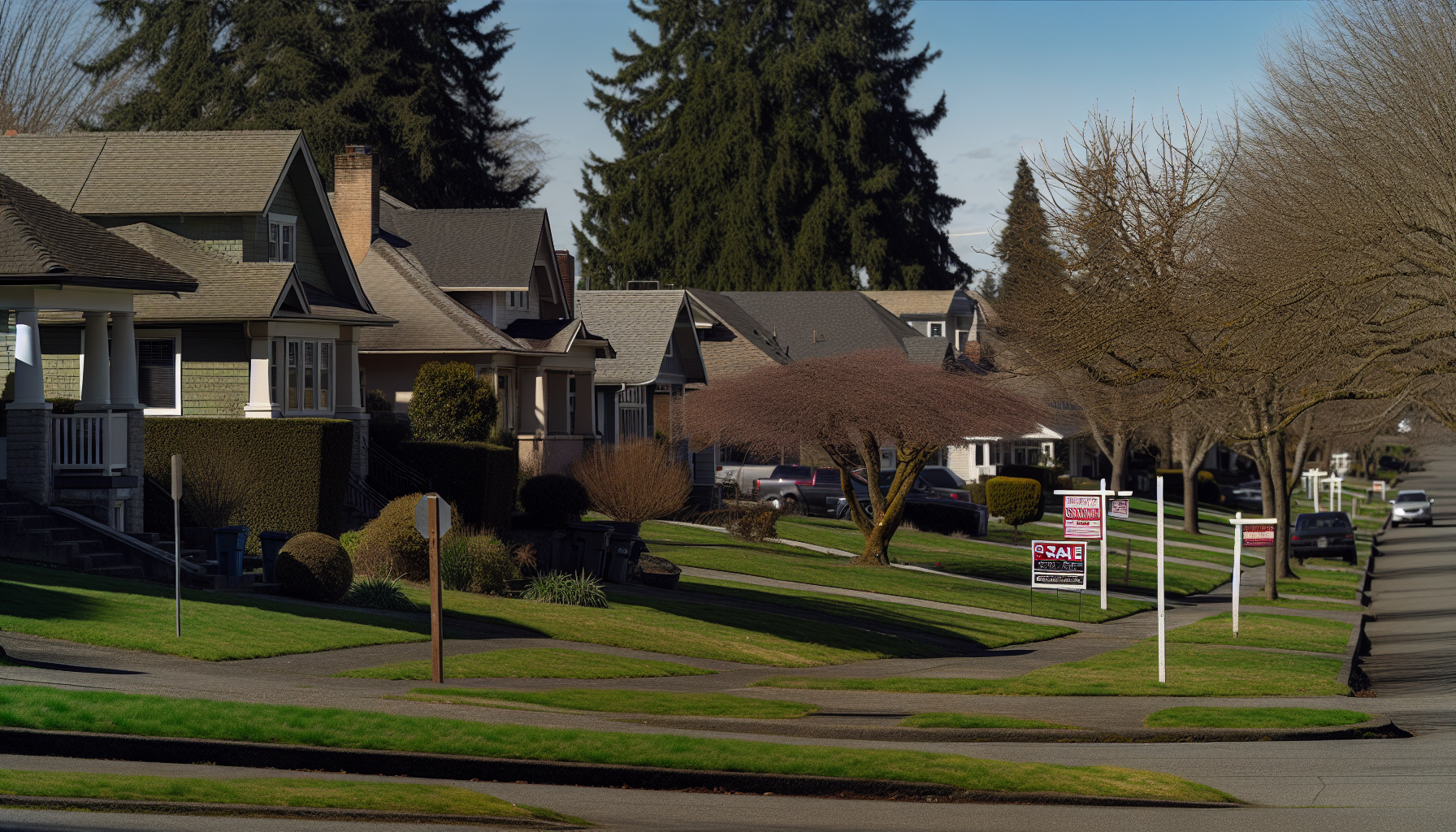The housing boom slowing is showing signs of becoming a reality. With data pointing to fewer bidding wars and longer listings, the real estate market could be entering a new phase. This article takes a straightforward look at the evidence. It offers concise insights for homeowners, buyers, and market watchers alike. It will also help in understanding the housing boom slow down.
Key Takeaways
The housing market is showing signs of cooling with decreased bidding wars, a downward trend in home sales, and homes remaining on the market for longer periods.
The Federal Reserve’s stance on interest rates is leading to higher mortgage costs and significant affordability challenges for potential homebuyers, particularly first-time buyers.
Despite a general market slowdown, housing supply remains low with persisting inventory shortages and uncertain new housing construction outlooks, which contribute to the high cost of homes.
Signs of the Housing Boom Cooling Off

The cyclical nature of the housing market is apparent as it begins to cool down. Skyrocketing home prices and bidding wars, once a staple of this vigorous market, are slowing down. However, a slowdown doesn’t inherently equate to a housing market crash. The current market conditions are much different from the 2008 foreclosure crisis, and we still find ourselves in a seller’s market.
We’ll further analyze this deceleration by observing three key indicators: diminishing bidding wars, downward trending home sales, and extended listing duration.
Easing of Bidding Wars
Remember the intense bidding wars that characterized the housing market in recent years? The ones that often led buyers into paying significantly over the asking price? They are becoming less common. Increasing mortgage rates, global economic dynamics, and rate increases by the federal reserve bank are all contributing to this reduction. In fact, data shows a clear downward trend.
In 2021, homes sold in February received an average of four offers. In 2022, however, only 48% of homes for sale received three or more offers. This significant decrease in bidding wars could lead to a stabilization of house prices, offering a glimmer of hope for first-time homebuyers.
Home Sales Trending Downward
Another key indicator of the cooling housing market is the downward trend in existing home sales. Factors such as changing demographics, unexpected global events, foreclosures, and rising interest rates are all contributing to this decline. The national statistics paint a clear picture: there has been a 0.8% decrease in November, a 4.1% drop in October, and a significant 15.4% fall from September of the previous year to September 2023. This trend is leading to high prices and tight inventory in the real estate market, and it’s anticipated that lower mortgage rates may help alleviate some of these negative impacts.
Increased Listing Duration
Homes are now staying on the market longer. Previously, in a stable real estate market, the typical duration of home listings was approximately 30 days. However, several factors have led to an extended listing duration. These include:
Comparable home values
The age, size, and condition of a property
Neighborhood appeal
The overall health of the housing market
An extended listing duration can influence buyers’ perception of a property’s attractiveness and lead to heightened competition among homebuyers, potentially resulting in increased offers per listing and higher sale prices.
The Fed’s Influence: Interest Rates and Mortgage Costs

The Federal Reserve’s influence on interest rates and mortgage costs plays a pivotal role in the housing market. The Fed’s benchmark interest rate, which indirectly impacts mortgage rates, shapes the affordability landscape for potential buyers. Currently, the Fed is committed to achieving a 2% inflation rate and has signaled that reducing interest rates is not a priority in the immediate future.
This stance, coupled with predictions of moderate interest rates by 2025, can pose substantial affordability challenges for potential buyers. We will examine these challenges more deeply, focusing on escalating mortgage rates and affordability obstacles for prospective buyers.
Rising Mortgage Rates
Mortgage rates, including mortgage interest rates, have been on the rise, posing a challenge for potential buyers looking to enter the market. Over the past year, mortgage rates have fluctuated within a range of 6% to 7%, increasing the cost of borrowing for potential buyers. This rise in mortgage rates, coupled with the elevated house prices, puts a severe strain on affordability.
For many, the dream of homeownership is becoming increasingly elusive, forcing them to continue renting or delay their plans as home buyers.
Affordability Challenges for Would-Be Buyers
As mortgage rates climb and house prices remain high, affordability challenges for would-be buyers are becoming more prevalent. The rising cost of borrowing is pushing monthly mortgage payments higher, making it harder for potential buyers to afford a home.
This affordability crunch is particularly challenging for first-time buyers who may not have the necessary down payment saved or the credit history to secure a favorable mortgage rate. As a result, many potential buyers are being priced out of the market, further exacerbating the housing slowdown.
The Housing Supply Equation
While demand plays a significant role in the housing market dynamics, supply cannot be overlooked. The housing supply equation remains a significant factor in the market slowdown. As of the conclusion of July 2023, the overall housing inventory stood at 1.11 million units, with a 2% decrease compared to the previous year by October 2023. This shortage of supply, coupled with the decreased rate of new constructions, suggests that the housing inventory will remain low for the foreseeable future.
We will examine this issue in more detail, focusing on the continual low inventory and the future of new constructions.
Persisting Low Inventory

The persisting low inventory in the housing market is a significant contributor to the deceleration. The current housing inventory level in the United States is under 1 million units. Factors like increasing demand without sufficient supply and a lack of new construction are contributing to this ongoing low inventory.
The limited supply is leading to elevated housing prices as a result of heightened demand and competition among buyers. This is turning the market into a seller’s market, causing potential buyers to have fewer options.
New Construction Outlook
The outlook for new construction is uncertain at best. At present, the new construction rate in the US housing market stands at 1.674 million units. However, the overall forecast for 2024 suggests that housing inventory will remain at a low level.
Factors such as comparable home values, property characteristics, neighborhood appeal, and the overall market condition can influence the housing supply due to new construction projections.
Economic Indicators and Housing Market Projections
Economic indicators and housing market predictions provide valuable insights into the future of the housing market. The relationship between economic growth and the housing market is substantial, and a potential economic slowdown could severely impact the market.
Job market shifts also play a crucial role in driving housing demand and are closely linked to fluctuations in home prices. We will examine these elements in more depth, considering the possibility of an economic slowdown and shifts in the job market.
Potential for Economic Slowdown
An economic slowdown could have far-reaching implications for the housing market. As economic growth slows down, job creation may diminish, leading to a decrease in housing prices and a potential oversupply of houses for sale.
History serves as a stern reminder of this, as the housing market collapse in 2006 resulted in a significant economic slowdown with widespread impacts on global growth.
Job Market Shifts
Shifts in the job market can greatly influence housing demand and affordability. Recent changes in the job market, such as declining job openings and slower job growth, may impact housing demand by influencing the local workforce, raising rents, and increasing the barrier to entry for the labor market.
Moreover, the advent of remote work has led to rising home prices and rentals, significantly impacting residential real estate values.
Long-Term Trends Influencing Today’s Market
Long-term trends, such as demographic shifts, remote work, and urban vs. suburban dynamics, are shaping today’s housing market. They are subtly yet significantly influencing how we live and work, consequently affecting our housing choices and preferences. These trends are expected to persist, shaping the future of the housing market.
We will examine these trends in more detail, discussing demographic shifts and household formation, the influence of remote work, and the interplay between urban and suburban living.
Demographic Shifts and Household Formation
Demographic shifts and household formation patterns are playing a crucial role in shaping housing demand. Current demographic changes, such as the influence of baby boomers on the housing market as they retire, and the impact of their downsizing on the supply and demand of homes, are affecting the housing market.
Furthermore, emerging trends in household formation, such as an increase in the number of buyers teaming up with friends and family members to buy homes, are expected to ease housing cost uncertainties for renters and provide stability to the housing market.
Remote Work Revolution

The remote work revolution is reshaping housing preferences and demand. The shift to remote work has led to a change in housing preferences, with an inclination towards suburban living to accommodate the need for more space and comfort for home offices. This trend is observable as remote workers consider local or entirely new city relocations, leading to increased home prices and rentals and having a substantial impact on residential real estate values.
Urban vs. Suburban Dynamics
The dynamics between urban and suburban living are also playing a role in the deceleration of the housing market. The trend of urban flight to suburbs, driven by the need for more space and remote work opportunities during the pandemic, has significantly impacted the housing market. This has resulted in increased activity in suburban markets and potential overvaluation in certain areas.
Looking ahead, there may be a need for correction, especially in urban areas and vacation markets, which could experience price declines or a slowdown.
Financial Considerations for Current and Prospective Homeowners

Navigating the financial landscape is a critical part of the home buying process. For current and prospective homeowners, it’s important to understand and manage various financial considerations. These include:
Managing down payments amidst price fluctuations
Adapting selling strategies in a slower market
Deciding on the right timing to enter or exit the market
We will investigate these considerations in greater depth.
Managing Down Payments Amidst Price Fluctuations
Managing down payments amidst price fluctuations can be quite a challenge for buyers. As home prices rise, down payment amounts may increase as a percentage of the sale price. On the other hand, when home prices decrease, down payment amounts may decrease as a percentage of the sale price.
Effective methods for handling down payments during price fluctuations include adjusting home search criteria, exploring housing assistance programs, or considering unconventional financing.
Selling Strategies in a Slower Market
Selling strategies may need to adapt to a slower market. In a slower housing market, real estate pricing strategies may involve pricing the property at market value, or even slightly below market value, to attract buyers. Additionally, sellers may need to be prepared for more aggressive bidding and properties selling over the list price.
It’s also advisable to effectively utilize open houses and home staging to distinguish properties from competitors and appeal to a larger pool of potential buyers.
Timing the Market: Should You Wait?
Deciding whether to wait or buy now depends on individual circumstances and market conditions. An economic slowdown could lower mortgage rates and soften home prices due to fewer eligible buyers and reduced competition. However, delaying the purchase of a home during a recession presents both advantages and potential drawbacks.
If an individual is not prepared to make a home purchase, they should prioritize:
Increasing their savings
Enhancing their credit score
Conducting thorough research on areas that align with their housing requirements and financial constraints.
Regional Real Estate Rundown
Regional real estate trends offer a more nuanced understanding of the housing market’s deceleration. While some areas continue to experience strong housing demand and defy the slowdown, other regions are feeling the effects of the decelerating housing market more acutely.
We will examine this regional divergence by investigating the resilient hot spots and the areas most impacted by the deceleration.
Hot Spots Defying the Slowdown
Despite the overall slowdown, some real estate markets are showing remarkable resilience. Markets such as:
Kentucky
Mississippi
North Dakota
Florida
West Virginia
These areas are defying the housing slowdown. Limited inventory and high demand are the defining characteristics of these markets. As job opportunities expand in these areas, they attract more individuals to relocate, resulting in heightened demand for housing. This surge in demand can elevate housing prices and foster a competitive environment for potential homebuyers.
Areas Hit Hardest by the Deceleration
On the other hand, some regions are feeling the effects of the decelerating housing market more acutely. The decelerating housing market has resulted in reduced spending and limited job growth in sectors tied to housing.
Furthermore, the local housing market in the hardest-hit areas has suffered greatly, with substantial declines in home prices in some instances.
Summary
In conclusion, the deceleration of the housing market is a multi-faceted phenomenon influenced by a multitude of factors. From the cooling off of the housing boom and the influence of the Federal Reserve, to the persisting low inventory and the potential for an economic slowdown, the housing market’s landscape is complex and ever-evolving. Long-term trends like demographic shifts, the remote work revolution, and urban-suburban dynamics also play crucial roles. While challenges abound, understanding these dynamics can equip current and prospective homeowners to navigate the market more effectively.
Frequently Asked Questions

Will 2024 be a good time to buy a house?
Given the predictions for a drop in median home prices and the favorable market conditions around early October of2023, 2024 seems like a good time to consider buying a house.
What time of year is the housing market slowest?
The housing market is typically slowest during the winter, making it a great time to find motivated sellers and potentially get a good deal on a home.
Is market expected to fall more in 2024?
It depends on the Federal Reserve’s impact, with analysts divided on the market’s direction for 2024.
How is the Federal Reserve influencing the housing market?
The Federal Reserve indirectly influences the housing market by adjusting its benchmark interest rate, which impacts mortgage rates and housing affordability. This means that changes in the Fed’s interest rate can affect the cost of borrowing for homebuyers, potentially impacting the housing market.
What is the current state of housing supply?
The current state of housing supply remains low due to increased demand and a lack of new construction.

Leave a Reply